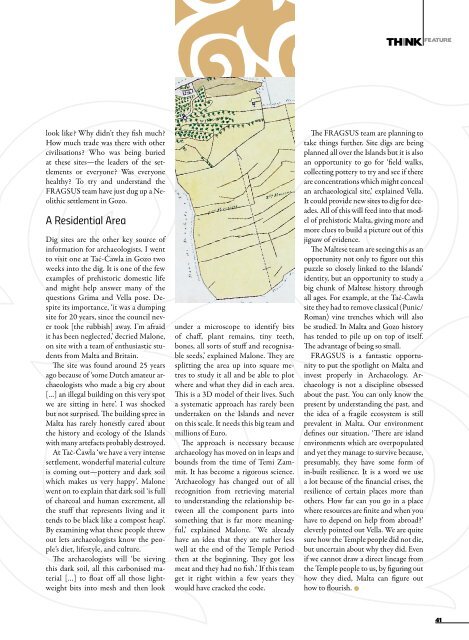Create successful ePaper yourself
Turn your PDF publications into a flip-book with our unique Google optimized e-Paper software.
THINK Feature<br />
look like? Why didn’t they fish much?<br />
How much trade was there with other<br />
civilisations? Who was being buried<br />
at these sites—the leaders of the settlements<br />
or everyone? Was everyone<br />
healthy? To try and understand the<br />
FRAGSUS team have just dug up a Neolithic<br />
settlement in Gozo.<br />
A Residential Area<br />
Dig sites are the other key source of<br />
information for archaeologists. I went<br />
to visit one at Taċ-Ċawla in Gozo two<br />
weeks into the dig. It is one of the few<br />
examples of prehistoric domestic life<br />
and might help answer many of the<br />
questions Grima and Vella pose. Despite<br />
its importance, ‘it was a dumping<br />
site for 20 years, since the council never<br />
took [the rubbish] away. I’m afraid<br />
it has been neglected,’ decried Malone,<br />
on site with a team of enthusiastic students<br />
from Malta and Britain.<br />
The site was found around 25 years<br />
ago because of ‘some Dutch amateur archaeologists<br />
who made a big cry about<br />
[…] an illegal building on this very spot<br />
we are sitting in here’. I was shocked<br />
but not surprised. The building spree in<br />
Malta has rarely honestly cared about<br />
the history and ecology of the Islands<br />
with many artefacts probably destroyed.<br />
At Taċ-Ċawla ‘we have a very intense<br />
settlement, wonderful material culture<br />
is coming out—pottery and dark soil<br />
which makes us very happy’. Malone<br />
went on to explain that dark soil ‘is full<br />
of charcoal and human excrement, all<br />
the stuff that represents living and it<br />
tends to be black like a compost heap’.<br />
By examining what these people threw<br />
out lets archaeologists know the people’s<br />
diet, lifestyle, and culture.<br />
The archaeologists will ‘be sieving<br />
this dark soil, all this carbonised material<br />
[…] to float off all those lightweight<br />
bits into mesh and then look<br />
under a microscope to identify bits<br />
of chaff, plant remains, tiny teeth,<br />
bones, all sorts of stuff and recognisable<br />
seeds,’ explained Malone. They are<br />
splitting the area up into square metres<br />
to study it all and be able to plot<br />
where and what they did in each area.<br />
This is a 3D model of their lives. Such<br />
a systematic approach has rarely been<br />
undertaken on the Islands and never<br />
on this scale. It needs this big team and<br />
millions of Euro.<br />
The approach is necessary because<br />
archaeology has moved on in leaps and<br />
bounds from the time of Temi Zammit.<br />
It has become a rigorous science.<br />
‘Archaeology has changed out of all<br />
recognition from retrieving material<br />
to understanding the relationship between<br />
all the component parts into<br />
something that is far more meaningful,’<br />
explained Malone. ‘We already<br />
have an idea that they ate rather less<br />
well at the end of the Temple Period<br />
then at the beginning. They got less<br />
meat and they had no fish.’ If this team<br />
get it right within a few years they<br />
would have cracked the code.<br />
The FRAGSUS team are planning to<br />
take things further. Site digs are being<br />
planned all over the Islands but it is also<br />
an opportunity to go for ‘field walks,<br />
collecting pottery to try and see if there<br />
are concentrations which might conceal<br />
an archaeological site,’ explained Vella.<br />
It could provide new sites to dig for decades.<br />
All of this will feed into that model<br />
of prehistoric Malta, giving more and<br />
more clues to build a picture out of this<br />
jigsaw of evidence.<br />
The Maltese team are seeing this as an<br />
opportunity not only to figure out this<br />
puzzle so closely linked to the Islands’<br />
identity, but an opportunity to study a<br />
big chunk of Maltese history through<br />
all ages. For example, at the Taċ-Ċawla<br />
site they had to remove classical (Punic/<br />
Roman) vine trenches which will also<br />
be studied. In Malta and Gozo history<br />
has tended to pile up on top of itself.<br />
The advantage of being so small.<br />
FRAGSUS is a fantastic opportunity<br />
to put the spotlight on Malta and<br />
invest properly in Archaeology. Archaeology<br />
is not a discipline obsessed<br />
about the past. You can only know the<br />
present by understanding the past, and<br />
the idea of a fragile ecosystem is still<br />
prevalent in Malta. Our environment<br />
defines our situation. ‘There are island<br />
environments which are overpopulated<br />
and yet they manage to survive because,<br />
presumably, they have some form of<br />
in-built resilience. It is a word we use<br />
a lot because of the financial crises, the<br />
resilience of certain places more than<br />
others. How far can you go in a place<br />
where resources are finite and when you<br />
have to depend on help from abroad?’<br />
cleverly pointed out Vella. We are quite<br />
sure how the Temple people did not die,<br />
but uncertain about why they did. Even<br />
if we cannot draw a direct lineage from<br />
the Temple people to us, by figuring out<br />
how they died, Malta can figure out<br />
how to flourish.<br />
•<br />
41


